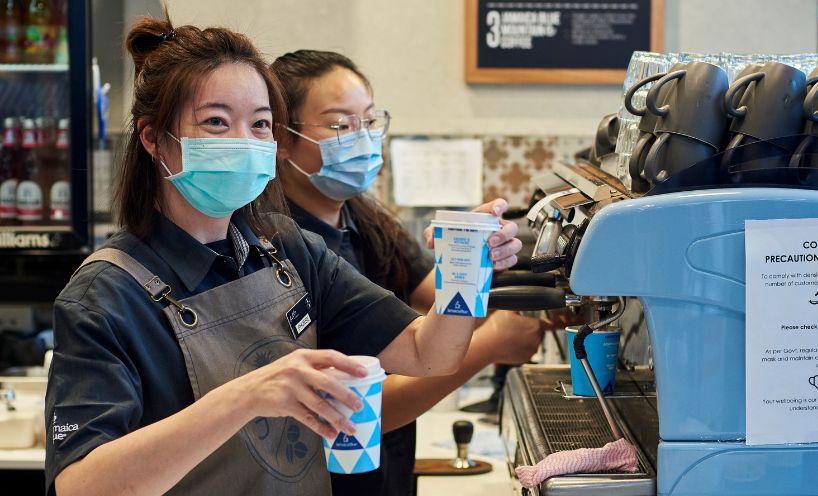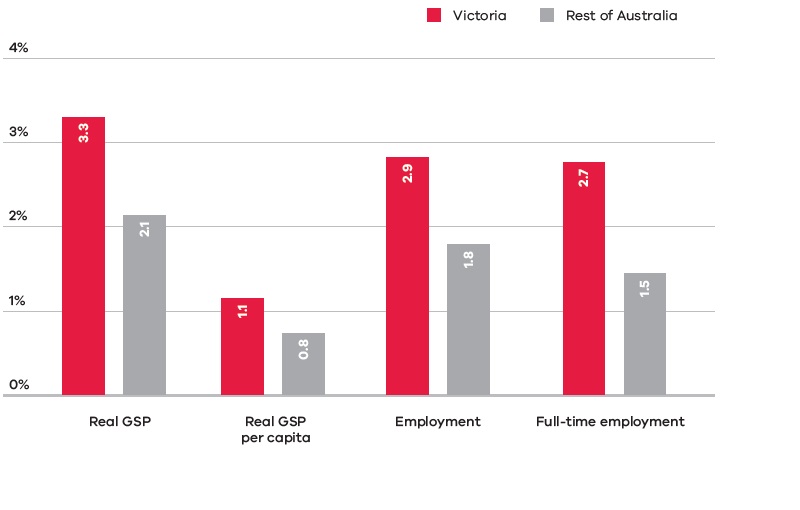
Unprecedented impact of the pandemic
No matter where you lived in the world, 2020 was a year like no other.
At the start of the year, Victorians faced a devastating bushfire season. Weeks later, a global pandemic – a one in one hundred year event – arrived at our doorstep.
The pandemic sent shockwaves through economies big and small, right across the globe.
At home and abroad, economic activity fell – sharply. Millions of people lost their jobs. Borders closed, and international students, tourists and migrants stopped coming.
Business and consumer confidence fell sharply. It was the biggest global recession since the Great Depression.
In Victoria, we experienced the first economic downturn in 28 years. Victorian state final demand fell by a record 8.2% in the June quarter 2020, driven by an unprecedented 14.3% fall in consumer spending. About 240,000 Victorians lost their jobs between March and September 2020. Young people were among the hardest hit, with employment for those under 30 falling by 15% during that time.
Women and young workers faced significantly greater increases in unemployment, as they were more likely to work in industries that were hardest hit during the pandemic – such as accommodation and food services. On top of that, we know women were more likely to take on caring responsibilities during remote learning in 2020.
The pandemic also tested Victoria’s health system like never before. COVID patients were just one part of the picture: the pandemic disrupted care, slowed down recovery times, and saw people putting off visits to their GPs. All of this put huge demand on our hospitals and healthcare professionals. We can never thank them enough for everything they did to protect Victorians, and to keep delivering the very best of care.
We knew that without record levels of support from government, these impacts would be far worse. And we knew we had to act – fast. That meant protecting and creating jobs. Looking after families. And taking care of Victorians’ loved ones.
A position of strength to respond
Before the pandemic, Victoria’s economy faced a very different scenario.
Economic growth and employment growth were particularly strong, averaging 3.3% and 2.9% a year, respectively, over the five years to 2018-19 – and the highest of all the states.
The unemployment rate had fallen to a 10-year low of 4.6% in 2018-19.
The Victorian economy was experiencing an extended period of strong jobs growth, with over 468,000 new jobs created between November 2014 and March 2020 – more than any other state or territory.
Victoria's economic performance was the highest of the states.
It’s no accident that Victoria’s economy was so strong.
Before the pandemic, we were borrowing to build – within our means. And without the pandemic, we would have had surpluses every single year.
Key State Fiscal Performance from 2015-16 to 2018-19:
Average net operating surpluses of $2.2 billion a year.
Indeed, in each budget before the pandemic, the Victorian Government delivered consistent operating surpluses, while building the roads, rail, schools and hospitals that matter to Victorians.
As a result of the Government’s strong financial management, Victoria had sound public finances coming into the pandemic. That provided significant scope to support Victorians when they needed it most. We were in a strong position to face this one in one hundred year crisis.
Selected economic indicators for Victoria and the rest of Australia, 2013-14 to 2018-19

Pandemic expenditure by category
$21.2 billion
spent on business, economic & worker support from 2019-20 - 2022-23(a)
$16.3 billion
spent on equipping our health system from 2019-20 to 2022-23
$2.6 billion
spent on household support from 2019-20 to 2022-23
$40.1 billion
Total spent (b)
$8.7 billion
in funding received from the Commonwealth Government
$31.5 billion
borrowed by the State Government
Source: Department of Treasury and Finance
Notes:
(a) Includes budget funding of $238.3 million in 2023-24 for COVID-19 impacts on the transport network, as published in Budget Paper 3, 2023-24 Budget, Chapter 1.
(b) Forecase expenditure for 2022-23.
Acting quickly to protect Victorians
As the pandemic hit Victoria, we borrowed billions of dollars to prevent economic scarring that would have left a generation out of work.
We acted on the advice of the Reserve Bank of Australia – just like every other state and territory across the country – and borrowed to support our economy. Countries across the world did the same.
We used the state budget to protect household budgets and businesses. We directly invested almost $40.1 billion to keep Victorians safe from the virus, keep workers in jobs and businesses afloat, and support households. We provided rent relief so Victorians could keep a roof over their heads, helped people test and isolate, added extra mental health services and relieved the stress on businesses with direct financial support.
A resilient health and care system
As a government, we knew there would be no economic recovery without a health recovery first. That’s why we moved swiftly to prepare our healthcare system as the pandemic reached our shores: procuring equipment and PPE supplies, providing dedicated spaces for patients, hiring thousands more healthcare workers and acquiring innovative technology to deal with the potential incoming demand.
Throughout the pandemic we acted decisively, putting in place vital public health measures that kept Victorians safe – and secured a stable foundation for recovery.
Our nurses, doctors, paramedics and allied healthcare workers set the most powerful examples of compassion and selflessness right throughout the pandemic. Across Victoria, they:
- Set up a network of more than 300 testing sites.
- Administered more than 23 million PCR tests.
- Delivered more than 17 million doses of vaccines.
- Treated 42,319 COVID-19 patients.
- Distributed more than 130 million rapid antigen tests.
- Distributed more than 7 million single-use and reusable masks to Victoria’s most vulnerable people including people with a disability and indigenous Victorians.
Between 2019-20 and 2022-23, we invested $16.3 billion in health-related services and programs. That investment funded more paramedics, triage care, and support staff in Ambulance Victoria, eased pressure on our busy emergency departments and delivered more hospital beds across the state.
We invested in extra personal protective equipment, testing outreach, drive-through testing sites, wastewater surveillance and new testing methods such as genomic sequencing. As Victorians banded together to get vaccinated in record numbers – which included hitting our 90% double-dose target in November 2021 for adults – we protected the most vulnerable people in our community from COVID, and strengthened our defence against future pandemics.
Pandemic Repair Plan
In last year’s Budget, we announced a plan for more staff, better hospitals and first-class care. This built on the $13.7 billion that had been spent on COVID-related health responses between 2019-20 and 2021-22.
As part of the Pandemic Repair Plan, we provided $12 billion over the period from 2019-20 to 2025-26, to give a much-needed boost to our health system, including:
- Delivering record levels of surgical capacity across the state, to give Victorians the specialist care they need – before they end up in the emergency department.
- Increased health services and new and improved health infrastructure, so all Victorians have access to high-quality healthcare, closer to home.
- More nurses, doctors, paramedics, with training and hiring of up to 7,000 new healthcare workers, including 5,000 nurses.
- Increased call-taking and dispatch capacity for our Triple Zero services including ambulances.
This will mean improved healthcare over coming years for Victorians.
Supporting businesses and the economy
Our work to support economic recovery across the state allowed Victoria to recover rapidly once public health restrictions were eased, driving a surge in jobs growth.
To help Victorian businesses and their staff, we invested $21.2 billion in economic assistance, with more than $14 billion in business and economic support.
We provided small to medium-sized businesses with direct grant and non-grant support to help them retain their employees and get through the pandemic. In addition, we provided just under $1 billion in payroll tax relief to businesses by providing refunds and waivers for small and medium-sized businesses.
Our grants supported hospitality, entertainment and tourism businesses, non-essential local retail and other small businesses such as florists and garden supplies.
A range of other support was provided to keep the state's economy and businesses afloat, including:
- Mental health and financial counselling support.
- Grants to help businesses improve ventilation to protect health and safety of customers.
- Solvency funding to keep our key arts and sporting institutions operating and ensure they remained viable.
- Programs that provided incentives for Victorians to go to restaurants, cinemas and travel across our state when health restrictions eased.
Crucially, these measures ensured the Victorian economy could bounce back once the worst of the pandemic was over.
Supporting households and communities
Right across the state, communities showed incredible strength in adapting to different ways of working, living and staying connected through the pandemic. We invested $2.6 billion to make sure households and communities were supported during this challenging time, as we worked to stop the spread of the virus, and to avoid further damage to the economy.
This meant making sure schools and training providers could stay connected to students, and keep providing the vital education services they needed. It also meant ensuring eligible government school students could keep their school-owned computers to stop them from falling behind.
We invested to support safe and sustainable public transport and commercial passenger vehicle services, undertaking rigorous cleaning and passenger protection measures to slow the spread of COVID while maintaining services for the essential workers who needed them.
And we acted swiftly to help move 2,000 Victorians in need into short-term accommodation. To further prevent the spread of COVID, we provided tailored communications and engaged multicultural communities so that they could receive up to date advice on public health restrictions, health and safety requirements, and the support available to them.
Reviewed 22 May 2023

